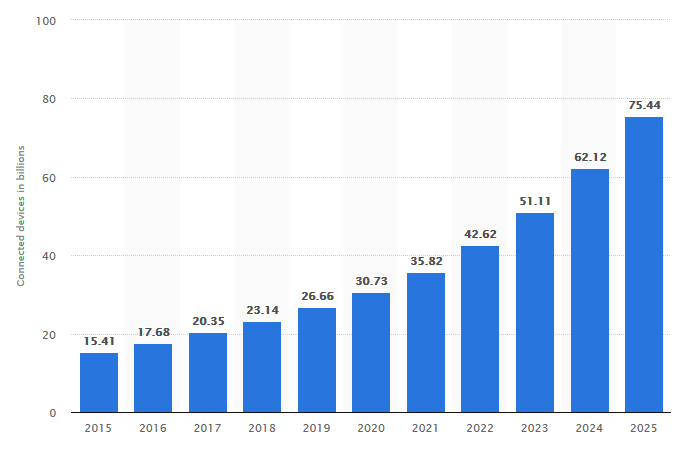
In 2016, Statista predicted that were would be over 42 billion connected IoT devices worldwide by 2022.

This figure was grossly overestimated as just 14.4 billion IoT connected devices were identified globally in 2021 and the % increase YoY was significantly lower than previous years.
Several reasons exist for this discrepancy, most notably one which could never have been predicted: the COVID-19 pandemic. This, along with rapid adoption of 5G technology contributed to the global semiconductor chip shortage, which in turn has had a detrimental impact across several IoT industries: in 2021 the auto industry lost approximately $200 billion, and 11 million less vehicles were manufactured. The shortage has also caused huge problems for the Telecoms industry, affecting the entire supply landscape. It's unsurprising that all of this has slowed IoT growth.
However, understanding the diversity of connected devices remains a challenge for mobile network operators, and there is a real need to understand the implications for networks. Operators need deeper insight into the nature and capabilities of terminals.
Device Map has many property classifications which provide granular visibility of traffic from diverse sources such as cameras, data collection terminals, wireless hot spots and many more.
The market problem
The challenge for operators is that many of the new classes of terminal have very different behaviours on the network compared with traditional voice and data capable cellphones.
As a result, they need to reliably segment this traffic to understand patterns and trends of network usage.
Two examples of problems that operators need to address include:
- Capacity at a cell tower level for IoT devices: the operator wants to measure IoT activity levels on a per-cell basis to assess whether the capacity reservations are optimal (both under-reserving and over-reserving lead to inefficiencies)
- Rate plan misuse: since different data rate plans are provided for IoT vs consumer devices, the operator must be able to monitor whether a device in use aligns with its rate plan
The Device Map solution
Device Map includes a set of properties to identify IoT devices:
| Property Name | Property Description | Example |
|---|---|---|
| IoT Endpoint | Sensor and/or actuator, with cellular connectivity | Camera, Data Collection Terminal, Geo-location tracker |
| IoT Enabler | Provides cellular connectivity to otherwise unconnected devices | Embedded network module, modem |
| IoT Controller | Data receiver and aggregator, command/control of remote and/or local IoT devices | Digital home assistant |
The benefits of these properties for Operators include:
- A simplified analysis and comparison of traffic types to permit accurate capacity allocation in the network
- The ability to measure IoT traffic trends, including correct use of rate plans
- Distinguishing between traffic which is 100% IoT (IoT Endpoints) and traffic which may represent a mix of IoT and non-IoT traffic (IoT Enablers)
Other uses
Where the operator needs to distinguish between consumer devices and M2M devices, the primary hardware type property can be used. This contains the classes below:
- Bicycle Lock
- Camera
- Cellular Gateway
- Data Collection Terminal
- Desktop
- Digital Home Assistant
- Digital Signage Media Player
- Electricity Meter
- Electrical Socket Adaptor
- Embedded Network Module
- eReader
- Fixed Wireless Phone
- Games Console
- Geolocation Tracker
- Glasses
- Media Player
- Medical Transmitter
- Meter Hub
- Mobile Phone
- Payment Terminal
- Plug-in Modem
- Projector
- Refrigerator
- Security Hub
- Set Top Box
- SIM Adaptor
- Single-board Computer
- SMS Controller
- Tablet
- TV
- Vehicle Multimedia System
- Vehicle Phone
- Weighing Scale
- Wireless Hotspot
- Wristwatch
Items to note:
- Many IoT devices communicate via WiFi, hence where traffic is seen from a WiFi hotspot on the mobile network, this may represent a mix of IoT and non-IoT devices.
- Many IoT devices use an Embedded Network Module to obtain cellular connectivity, with a non-distinguishing TAC. Hence a high proportion of traffic from Embedded Network Modules is likely to represent IoT devices.
Main Image By Timusu via Pixabay.




